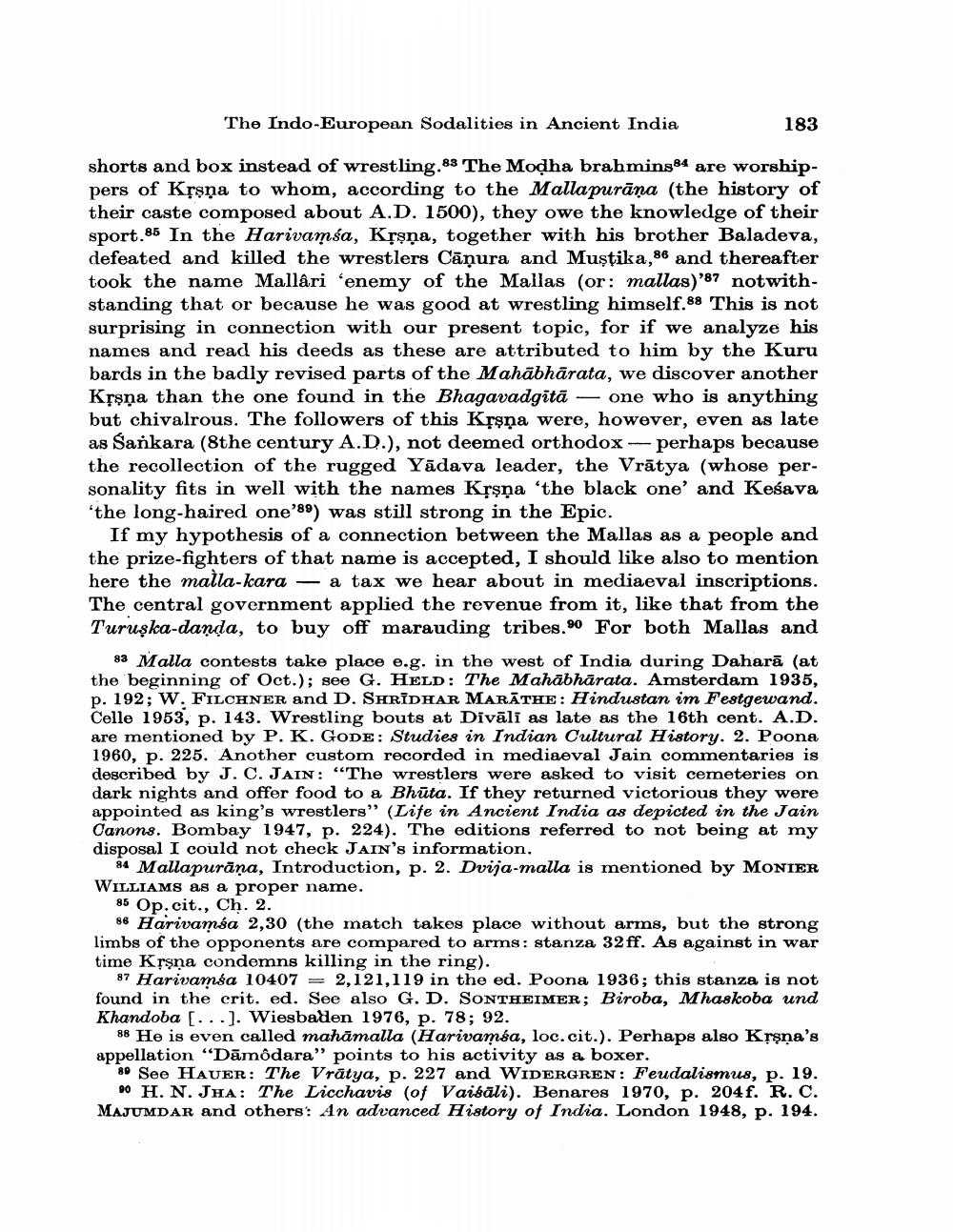________________
The Indo-European Sodalities in Ancient India
183
shorts and box instead of wrestling.83 The Modha brahmins84 are worshippers of Krşņa to whom, according to the Mallapurāņa (the history of their caste composed about A.D. 1500), they owe the knowledge of their sport.85 In the Harivamsa, Krşņa, together with his brother Baladeva, defeated and killed the wrestlers Cāņura and Musţika,86 and thereafter took the name Mallâri “enemy of the Mallas (or: mallas)'87 notwithstanding that or because he was good at wrestling himself.88 This is not surprising in connection with our present topic, for if we analyze his names and read his deeds as these are attributed to him by the Kuru bards in the badly revised parts of the Mahābhārata, we discover another Kțşņa than the one found in the Bhagavadgitā — one who is anything but chivalrous. The followers of this Kļşņa were, however, even as late as Sankara (8the century A.D.), not deemed orthodox - perhaps because the recollection of the rugged Yādava leader, the Vrātya (whose personality fits in well with the names Krşņa 'the black one' and Keśava 'the long-haired one'89) was still strong in the Epic.
If my hypothesis of a connection between the Mallas as a people and the prize-fighters of that name is accepted, I should like also to mention here the malla-kara — a tax we hear about in mediaeval inscriptions. The central government applied the revenue from it, like that from the Turuşka-danda, to buy off marauding tribes.90 For both Mallas and
83 Malla contests take place e.g. in the west of India during Daharā (at the beginning of Oct.); see G. HELD: The Mahābhārata. Amsterdam 1935, p. 192; W. FILCHNER and D. SHRIDHAR MARĀTHE: Hindustan im Festgewand. Celle 1953, p. 143. Wrestling bouts at Divāli as late as the 16th cent. A.D. are mentioned by P. K. GODE: Studies in Indian Cultural History. 2. Poona 1960, p. 225. Another custom recorded in mediaeval Jain commentaries is described by J.C. JAIN: "The wrestlers were asked to visit cemeteries on dark nights and offer food to a Bhūta. If they returned victorious they were appointed as king's wrestlers" (Life in Ancient India as depicted in the Jain Canons. Bombay 1947, p. 224). The editions referred to not being at my disposal I could not check JAIN's information.
84 Mallapurāna, Introduction, p. 2. Dvija-malla is mentioned by MONIER WILLIAMS as a proper name.
85 Op.cit., Ch. 2.
86 Harivamsa 2,30 (the match takes place without arms, but the strong limbs of the opponents are compared to arms: stanza 32 ff. As against in war time Krsna condemns killing in the ring).
87 Harivamsa 10407 = 2,121,119 in the ed. Poona 1936; this stanza is not found in the crit. ed. See also G. D. SONTHEIMER; Biroba, Mhaskoba und Khandoba [...]. Wiesbaden 1976, p. 78; 92.
88 He is even called mahāmalla (Harivaméa, loc. cit.). Perhaps also Krşņa's appellation "Dāmôdara' points to his activity as a boxer. 89 See HAUER: The Vrātya, p. 227 and WIDERGREN: Feudalismus, p. 19.
90 H. N. JHA: The Licchavis (of Vaisāli). Benares 1970, p. 204f. R. C. MAJUMDAR and others: An advanced History of India. London 1948, p. 194.




